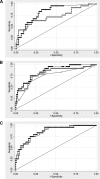Patient Characteristics, Management, and Predictors of Outcome from Severe Community-Onset Staphylococcal Sepsis in Northeast Thailand: A Prospective Multicenter Study
- PMID: 28167592
- PMCID: PMC5417193
- DOI: 10.4269/ajtmh.16-0606
Patient Characteristics, Management, and Predictors of Outcome from Severe Community-Onset Staphylococcal Sepsis in Northeast Thailand: A Prospective Multicenter Study
Abstract
AbstractStaphylococcus aureus infection is a persistent threat in resource-restricted settings in southeast Asia but informative data about this disease remain limited. We analyzed characteristics, management, and predictors of outcome in severely septic patients with community-onset S. aureus infection in northeast Thailand. We performed a prospective, multicenter observational cohort study of community-onset S. aureus sepsis in four referral hospitals recruiting patients at least 14 years of age admitted between March 2010 and December 2013. One hundred and nineteen patients with severe staphylococcal sepsis were enrolled. Diabetes was the most common underlying condition. Methicillin-resistant infection was rare. Twenty-eight-day mortality was 20%. Ninety-two percent of patients received appropriate antibiotic therapy and 82% were administered intravenous fluids on the first hospital day, although only 14% were managed in an intensive care unit (ICU). On univariable analysis, clinical variables at enrollment significantly associated with death at 28 days were coagulopathy or respiratory failure. Plasma interleukin (IL)-8 concentration alone accurately predicted mortality (area under the receiver operating curve = 0.82, 95% confidence interval = 0.73-0.90). In multivariable analysis, addition of IL-8 concentration to a mortality prediction model containing clinical variables further improved the predictive ability of the model. We conclude that severe staphylococcal sepsis in northeast Thailand causes significant mortality. Diabetes is a common preexisting condition and most patients are managed outside the ICU even if they receive vasoactive/inotropic agents or mechanical ventilation. While clinical factors apparent on presentation including coagulopathy and respiratory failure predict death, plasma IL-8 improves this prediction.
Figures



Similar articles
-
Comparison of community-onset Staphylococcus argenteus and Staphylococcus aureus sepsis in Thailand: a prospective multicentre observational study.Clin Microbiol Infect. 2016 May;22(5):458.e11-9. doi: 10.1016/j.cmi.2016.01.008. Epub 2016 Jan 22. Clin Microbiol Infect. 2016. PMID: 26806258 Free PMC article.
-
Clinical epidemiology and outcomes of community acquired infection and sepsis among hospitalized patients in a resource limited setting in Northeast Thailand: A prospective observational study (Ubon-sepsis).PLoS One. 2018 Sep 26;13(9):e0204509. doi: 10.1371/journal.pone.0204509. eCollection 2018. PLoS One. 2018. PMID: 30256845 Free PMC article.
-
Genomic characterization of Staphylococcus aureus isolated from patients admitted to intensive care units of a tertiary care hospital: epidemiological risk of nasal carriage of virulent clone during admission.Microbiol Spectr. 2024 Jun 4;12(6):e0295023. doi: 10.1128/spectrum.02950-23. Epub 2024 May 6. Microbiol Spectr. 2024. PMID: 38709078 Free PMC article.
-
[Staphylococcus aureus sepsis in hospitalized non neutropenic patients: retrospective clinical and microbiological analysis].Ann Ital Med Int. 2002 Jul-Sep;17(3):166-72. Ann Ital Med Int. 2002. PMID: 12402664 Review. Italian.
-
Community-acquired methicillin-resistant Staphylococcus aureus infections.Clin Lab Med. 2004 Jun;24(2):403-18. doi: 10.1016/j.cll.2004.03.007. Clin Lab Med. 2004. PMID: 15177847 Review.
Cited by
-
Predictive Validity of the qSOFA Score for Sepsis in Adults with Community-Onset Staphylococcal Infection in Thailand.J Clin Med. 2019 Nov 7;8(11):1908. doi: 10.3390/jcm8111908. J Clin Med. 2019. PMID: 31703403 Free PMC article.
-
Host-Based Prognostic Biomarkers to Improve Risk Stratification and Outcome of Febrile Children in Low- and Middle-Income Countries.Front Pediatr. 2020 Sep 18;8:552083. doi: 10.3389/fped.2020.552083. eCollection 2020. Front Pediatr. 2020. PMID: 33072673 Free PMC article.
-
Identification of Potential Transcriptional Biomarkers Differently Expressed in Both S. aureus- and E. coli-Induced Sepsis via Integrated Analysis.Biomed Res Int. 2019 Apr 9;2019:2487921. doi: 10.1155/2019/2487921. eCollection 2019. Biomed Res Int. 2019. PMID: 31093495 Free PMC article.
-
Risk stratification biomarkers for Staphylococcus aureus bacteraemia.Clin Transl Immunology. 2020 Feb 13;9(2):e1110. doi: 10.1002/cti2.1110. eCollection 2020. Clin Transl Immunology. 2020. PMID: 32082571 Free PMC article.
-
A nomogram for predicting the risk of sepsis in patients with acute cholangitis.J Int Med Res. 2020 Jan;48(1):300060519866100. doi: 10.1177/0300060519866100. Epub 2019 Aug 20. J Int Med Res. 2020. PMID: 31429338 Free PMC article.
References
-
- Nickerson EK, West TE, Day NP, Peacock SJ. Staphylococcus aureus disease and drug resistance in resource-limited countries in south and east Asia. Lancet Infect Dis. 2009;9:130–135. - PubMed
-
- Stoesser N, Moore CE, Pocock JM, An KP, Emary K, Carter M, Sona S, Poda S, Day N, Kumar V, Parry CM. Pediatric bloodstream infections in Cambodia, 2007 to 2011. Pediatr Infect Dis J. 2013;32:e272–e276. - PubMed
-
- Martin GS, Mannino DM, Eaton S, Moss M. The epidemiology of sepsis in the United States from 1979 through 2000. N Engl J Med. 2003;348:1546–1554. - PubMed
Publication types
MeSH terms
Substances
Grants and funding
LinkOut - more resources
Full Text Sources
Other Literature Sources
Medical

